
Pages:
<< Back 1
2 3 4
5 6 7
8 9 10
Next >>
When
Longden finally retired in 1935 at the age of 75, the office of
Rector secretary fell to G. Herbert Smith, who also served as dean
of freshman men. To assist the admissions process, recent DePauw
graduate Robert H. Farber became the first field representative,
visiting Indiana high schools to interview students interested in
attending the university. The dual post of director of publicity
and alumni secretary was created in 1931, with F. Russell Alexander
named to that office. Five years later Alexander issued the first
number of the DePauw Alumnus, the glossy-page successor to the earlier
Alumni News.
When the long-time treasurer, Salem B. Town, stepped down in 1929,
his assistant, Harold E. Robbins took his place. Fund raising came
under the jurisdiction of Byron H. Wilson, executive secretary of
endowments and promotion. In 1930 Ralph E. Schenck, a civil engineer
who had supervised the building of much of the physical plant in
recent years while in the employ of an Indianapolis construction
firm, was appointed superintendent of engineering, construction,
and maintenance.
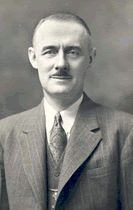 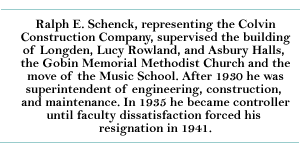
It was not until near the end of his administration, however, that
President Oxnam was able to persuade the trustees to authorize the
centralization of all business affairs in the new post of comptroller.
Named to this office in 1935 was Superintendent Schenck, who proceeded
to concentrate in it all matters relating to finances, purchasing,
real estate, and the physical plant. Ernest H. Smith became the
first chief accountant.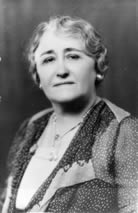
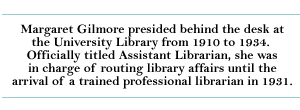
A major concern of the Oxnam administration was to strengthen the
operations of the library, which did not come up to the standards
of institutions with which DePauw liked to compare itself. Until
1931 the titular librarian was Professor Francis J. Tilden of the
comparative literature department, who left most of the work of
supervising the library in the hands of an assistant, Margaret Gilmore.
In that year Vera Southwick Cooper became the first professionally
trained librarian to serve the university. She was soon able to
increase the book budget and engage additional library staff, though
the limitations of physical space in the Carnegie building prevented
the enlargement of resources needed to meet the desired standards
fully.
 
In 1932 the School of Music was completely restructured and integrated
into the university. It had previously been operated more or less
autonomously under the direction of Dean Robert McCutcheon. He rented
facilities from DePauw and managed the school's affairs personally
- collecting student fees, employing faculty, and even providing
musical instruments and equipment. Now the instructional staff became
regular salaried members of the faculty for the first time. Moreover,
a music major and minor were accepted as part of the liberal arts
degree program, while the bachelor of music program was continued
in force.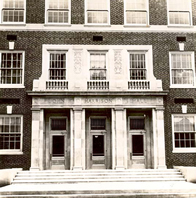

The
residential graduate program that had existed in name since 1884
was expanded and reorganized. Several departments offered graduate
work leading to a master of arts degree, and in 1931 the School
of Music announced the establishment of a master of music degree.
In 1934 the president appointed a graduate council to oversee the
graduate program, headed by Professor William E. Edington of the
mathematics department. Graduate enrollments at DePauw grew slightly
but remained only a small fraction of the total and never threatened
the university's basic commitment to undergraduate education.
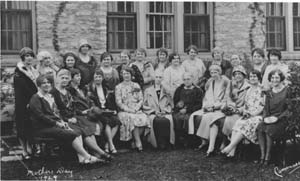 ______________________________ ______________________________
One of the traditions
at DePauw was inviting
the student mothers to campus on May Day
and the fathers on Dads' Day. Usually they
formed living unit clubs of particular financial
importance in enhancing the living condition.
Here are the charter members of the Phi Kappa
Psi Mothers Club in 1929. In the center of the
first row is Mrs. H. A. Gobin, widow of a
former president.
________________________________
In an endeavor to encourage high scholarship, the university in
1931 revived an honors program that had flourished in the last decades
of the 19th century. Various departments offered honors work in this
period, eventually including history, economics, sociology, political
science, psychology, and education. Students accepted for this program
spent much of their junior and senior year in independent study
under the direction of one or more members of the faculty in their
major field. A preliminary examination was given at the end of the
junior year, followed by both oral and written comprehensive examinations
in the senior year. Each successful candidate for honors also submitted
an extensive research paper in some field of specialization.
President
Oxnam's recommendation to the faculty in 1932 that all students
be required to pass a comprehensive examination was not acted upon
at this time. The only major change in graduation requirements adopted
by the faculty was to add six hours in philosophy or religion, a
partial reversion to the role of those subjects in the former prescribed
curriculum that dated back to the founding of the university.
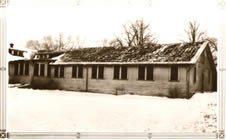 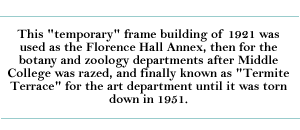
A few significant changes took place in the organization of the
liberal arts curriculum. In 1928 botany and zoology, which had been
merged from time to time into a department of biology, regained
independent departmental status. The department of public speaking
was renamed the speech department in 1929. Taking up new quarters
in Speech Hall (the former College Avenue Methodist Church), the
department was able to expand its work in both forensics and Little
Theatre.
An interesting development was the formation of a separate women's
debating team which took part in intercollegiate competition along
with the men's team. Upon the death of Professor Adelbert F. Caldwell
in 1931, his department of English literature was merged into the
department of English-formerly called English composition and rhetoric-under
the headship of Raymond W. Pence. In 1934 an art department was
created. It absorbed the courses in art history taught by Professor
of Greek Rufus Stephenson, and expanded the studio work carried
on by the School of Music since the demise of the art school in
1913.
In seeking increased administrative centralization of the university
President Oxnam undertook a complete reorganization of the faculty
and departmental structure. As early as January 1930 he began grouping
all departments into six divisions under chairmen appointed by him.
The latter were to preside over fortnightly meetings of the faculty
within each division. Together with the president, vice president,
and the dean of the university, they constituted an educational
policy committee.
General faculty meetings, held once a month under President Murlin,
were to be convened only upon call. The six divisions with their
first chairmen were as follows: Classical and Modern Languages (Edwin
Post); English, Speech, and Fine Arts (Raymond W. Pence); Sciences
(Orrin H. Smith); Social Sciences (W. Wallace Carson);Education,
Philosophy, and Religion (Walter E. Bundy); and Physical Education
(William L. Hughes).
In the fall of 1930 a committee from the Commission on Survey of
Educational Institutions of the Methodist Church visited the campus
and submitted an elaborate report that endorsed the notion that
divisions rather than departments be made the administrative units
of the university. Thus encouraged in his vision of a more efficient
and centralized system of operations, the president in May 1933
announced the abolition of the departmental structure altogether.
Department heads were also eliminated, their functions being assumed
by the division chairmen.
Back
to Top
Pages:
<< Back 1
2 3 4
5 6 7
8 9 10
Next >>
|










 ______________________________
______________________________
